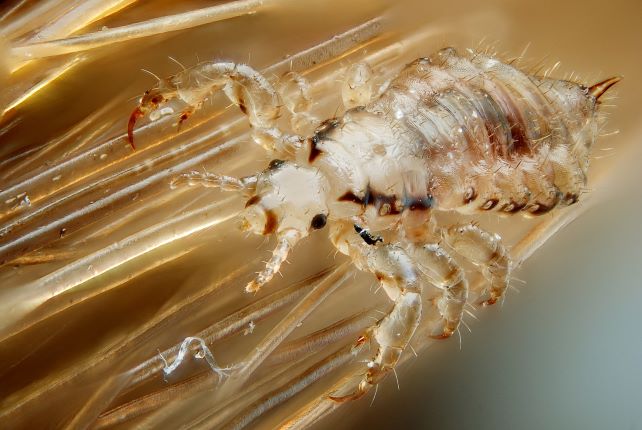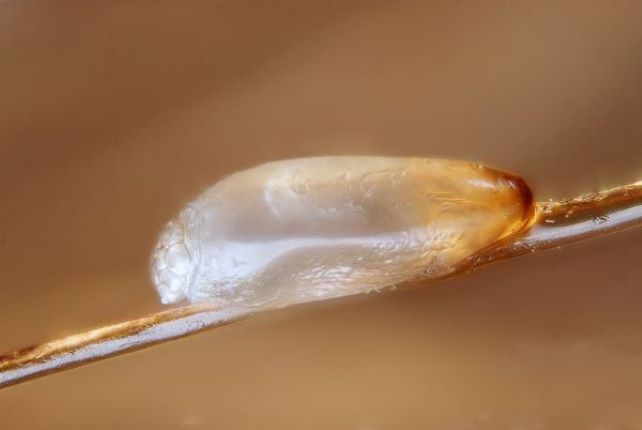What do head lice & nits look like?
When you consider that head lice are barely visible to the human eye, it’s understandable that a common question among parents is, ‘what do head lice look like?’ But wait, it’s not just head lice that you need to be on the lookout for, here we’ll also answer the question, ‘what do nits look like?’ to ensure you’ve got all areas covered when the little ones come home with itchy heads.
What do head lice look like?
Head lice can be hard to spot, this is because they’re tiny, wingless insects that grow to about the size of a sesame seed when fully matured1. Head lice are tan to grey in colour and have six legs which end in hook-like claws which help them hold onto hair.
Adult lice may be difficult to spot, but they can be even tougher in their nymph form. Nymphs are newly hatched, baby head lice. They look like an adult head louse but are only about the size of a pinhead. They have a pearly white colour to them and generally take between 7-10 days to mature into their larger adult form2.

Head lice infestations & why they make you itch
Head lice are classified as parasites. This is because they live on a person’s head and feed on human blood from the scalp up to four times a day1.
Itchy heads can be a symptom of head lice bites, though despite being somewhat repulsive, the tiny creatures are fairly harmless and don’t carry any diseases3. Despite some misconceptions, head lice can’t fly, jump or swim. They spread through head-to-head contact and this is why they’re particularly common in primary school children.
Head lice infestations are more common in girls than boys.3 This is because it’s believed that girls do more activities with their heads close together than boys.
How common are head lice?
A recent study found that 45% of school-aged children have suffered from head lice in the past 5 years4 and the risks of being infected has been significantly increased with smartphone or tablet use.4
The study also revealed that 55% of school children who took selfies with smartphones or tablets got head lice.4 This compares to only 30% infected of those who didn’t own a smartphone or tablet.4
There you have it, to all the parents who are trying to get their kids away from phones and tablets, you can just tell them they’ll get head lice!
What are nits?
You’ll often hear parents use the word ‘nits’ to describe head lice eggs. Technically, nits are just the empty shells of hatched louse eggs5. These turn white and remain attached to the hair, but further from the scalp surface5, which could be why they’re often more noticeable than head lice themselves.
Those who remember the ‘nit nurse’ from years gone by may recall the nurse cracking nit shells to see if they were live or empty. If the shell cracked easily, it was empty. If there was no cracking sound, you had a live egg.
These days, it’s said the only way to be sure someone has head lice is by finding live lice6.
So,What do head lice eggs look like?
Live lice eggs are small brown or tan coloured dots on hair shafts close to the scalp. These can be incredibly difficult to spot. Broken egg shells, or nits, are easier to spot.
It’s common for parents to mistake nits for dandruff. This is because they’re a whitish-translucent colour and are usually close to the scalp.
A good way to tell whether you’re dealing with nits or dandruff flakes is to pull on the small white speck with your fingers. Dandruff will be easy to remove, whereas nits will be harder to pull out as they’re glued to the hair shafts.
Where do head lice live?
Detecting head lice and nits can be a challenge for many parents, and it can feel a bit like you’re trying to find a needle in a haystack - especially when you’re dealing with long, thick hair.
The trick to finding the little critters is to know where they like to hang out. Head lice have favourite places to gather, also known as head lice ‘hotspots’.
Head lice like to live close to the scalp surface as this provides food, warmth, shelter and moisture. As a result, these hotspots tend to be at the nape of the neck, crown of the head and behind the ears7. Some parents have also noted that head lice like to hide behind ponytails or braids.
Adult lice and nymphs can’t survive too long away from a human host. Usually for only 1 or 2 days. Eggs can survive a little longer away from its human host (up to 3 days), but will need the warmth of a person’s scalp to hatch8.
How do I know if I have head lice?
Due to the idea that the only way to be sure whether someone has head lice is by finding live lice6, it’s worth checking every family member regularly. This should be especially the case if there are any school-aged children in your family.
A helpful tool in your arsenal for head lice treatment comes in the form of a specially designed fine-toothed detection comb - also known as the infamous ‘nit comb’.
A technique called wet-combing can be used for detecting and removing head lice9. This involves washing the hair with hot water and shampoo, then applying conditioner and using the nit-comb under a bright light to go through each section of the hair - removing any head lice, nits or eggs found after each brush. Once the process is complete, the conditioner should be washed out and the process started again.
Head lice treatment for busy families
Any parent who’s had to deal with kids suffering from head lice already knows, wet combing can be a lengthy process. It might take as little as 10 minutes on short hair. However, if you’re doing it on long, frizzy or curly hair, it can take 20 or even 30 minutes10.
For busy families, wet combing isn’t the best option because it can take longer than preferred. This is when an insecticide-free treatments can be a helpful alternative. These can come in the form of head lice treatment shampoos, lotions or spray.
Although it can be tricky to find and treat head lice, help is at hand. Pop in to your local pharmacy for medical advice, diagnosis or treatment tips.

References
1 Omega. (2014). Lyclear Category Training Booklet. Head Lice Training. Omega Pharma.
3 Head Lice: Overview – InformedHealth.org
4 Hitchen, N. (n.d.). Results of a survey over 1 month amoung parents/ guardians attending paediatric outpatients department. Oxford, UK: Oxford University Hospitals NHS Foundation Trust.
5 What is the life cycle of the head louse - NICE
7 Meister, L. (2016, November). Head Lice: Epidemiology, Biology, Diagnosis, and Treatment
10 Scenario: Management of head lice - NICE
